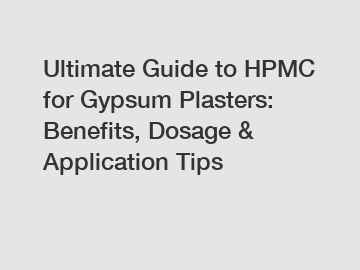Ultimate Guide to HPMC for Gypsum Plasters: Benefits, Dosage & Application Tips
Ding’ao Product Page
When it comes to gypsum plasters, using Hydroxypropyl Methylcellulose (HPMC) can provide numerous benefits. HPMC is a cellulose derivative that is commonly used as a thickening or binding agent in various construction materials. In the case of gypsum plasters, HPMC can enhance the workability, performance, and overall quality of the plaster. In this ultimate guide, we will explore the benefits of using HPMC for gypsum plasters, the recommended dosage, and some application tips to ensure optimal results.
Benefits of HPMC for Gypsum Plasters.

HPMC offers several key benefits when added to gypsum plasters. One of the main advantages is improved water retention, which helps to prevent premature drying of the plaster. This allows for better adhesion and reduced cracking during the curing process. Additionally, HPMC can enhance the strength and durability of the plaster, leading to a longer-lasting finish. It also improves the workability of the plaster, making it easier to apply and achieve a smooth, even surface. Overall, using HPMC in gypsum plasters can result in a higher quality, more consistent finish.
Dosage Recommendations.
When using HPMC in gypsum plasters, it is important to follow the recommended dosage guidelines to achieve the desired results. The dosage of HPMC will vary depending on the specific type of plaster being used and the desired properties. Generally, a dosage of 0.1% to 0.3% by weight of the dry mix is recommended for most gypsum plasters. However, it is important to refer to the manufacturer's guidelines and conduct some test batches to determine the optimal dosage for your specific application.
Application Tips.
To ensure the best results when using HPMC in gypsum plasters, there are a few key application tips to keep in mind. Firstly, it is important to thoroughly mix the HPMC into the dry mix before adding any water. This will help to evenly distribute the HPMC and improve its effectiveness in the plaster. Additionally, it is recommended to use clean, potable water when mixing the plaster to prevent any contamination that could affect the performance of the HPMC. Finally, be sure to follow the manufacturer's instructions for mixing and applying the plaster to achieve the best possible finish.
Conclusion.
In conclusion, using HPMC in gypsum plasters can offer a wide range of benefits, including improved water retention, strength, durability, and workability. By following the recommended dosage guidelines and application tips, you can achieve a high-quality finish that is long-lasting and consistent. If you are considering using HPMC in your gypsum plaster projects, be sure to consult with a professional to ensure the proper application and dosage. With the right approach, HPMC can help you achieve excellent results in your plastering projects.
Contact us.
If you have any questions or need assistance with using HPMC in your gypsum plasters, please do not hesitate to contact us. Our team of experts is here to help you achieve the best possible results in your construction projects.
For more hydroxypropyl starch etherinformation, please contact us. We will provide professional answers.



